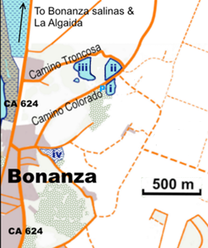
A second colony has also been established at Bonanza Pools (aka Lagunas de Camino Colorado) although, to be honest, I can't be 100% certain that this colony hasn't been present for rather longer.
| Birding Cadiz Province |
|
|
On my short visit to the province in March I was a little concerned that there was no sign of egrets, herons or Glossy Ibis at the usual nesting site on La Janda. Although Cattle Egrets, the dominant species here, only start to lay eggs in late April/early May, there's usually some activity here by March. My concern turned to alarm when I returned in late April to find that the huge heronry was still bereft of birds. This colony has been the highlight of any spring/early summer jaunt to La Janda for years. I'm sure that better informed people than me will know why it has been deserted but I suspect that its failure is likely to be connected with the exceptionally dry winter. However, I doubt that the absence of the egrets here means they're not breeding at all. Although egret colonies seem to persist in the same place over many years, like gulls and terns, birds may shift elsewhere if things aren't quite right. This appears to have happened to the egret colony that once nested in the reedbed near the Bald Ibis colony below Vejer de la Frontera and the unique cliff-nesting egret colony which the ibis were expected to join near Barbate.  There do seem to be some new, albeit much smaller, colonies of Cattle Egret in the province. For example, there now seems to be one in the trees along the Rio Barbate below my house in Alcala de los Gazules. Unfortunately, its on private land so I was unable to approach closely enough to prove it but from my terrace I could see that, unusually, birds were present in the trees pretty much all day. A second colony has also been established at Bonanza Pools (aka Lagunas de Camino Colorado) although, to be honest, I can't be 100% certain that this colony hasn't been present for rather longer. A combination of my enforced absence from Spain and plain idleness means that I've not actually looked at the third laguna here (iii on the map) for several years. The fact is that my main target here, White-headed Duck, is very easy to see on lagunas (i) and (ii) as are other attractions like Purple Swamphen and, more infrequently, birds like Little Bittern and Marbled Duck. Hence I've rarely bothered to check the third laguna and only did so in April because my keen young correspondent, Bruno Asencio Sevillano, had tipped me off about it. The Camino Truncosa allows good views of the colony which, as expected, consists largely of Cattle Egret but also a sprinkling of Squacco and Night Herons, Little Egret and Glossy Ibis. My total of 31 White-headed Duck which was far better than my combined tally at better known sites such as Laguna de Tarelo and Laguna de Medina which confirms the importance of this once neglected site. I failed to find the Red-knobbed Coot here but having seen one elsewhere didn't try too hard. It was good to see the water level so high here too after the low levels I found in March (see photos)
0 Comments
Leave a Reply. |
About me ...Hi I'm John Cantelo. I've been birding seriously since the 1960s when I met up with some like minded folks (all of us are still birding!) at Taunton's School in Southampton. I have lived in Kent , where I taught History and Sociology, since the late 1970s. In that time I've served on the committees of both my local RSPB group and the county ornithological society (KOS). I have also worked as a part-time field teacher for the RSPB at Dungeness. Having retired I now spend as much time as possible in Alcala de los Gazules in SW Spain. When I'm not birding I edit books for the Crossbill Guides series. CategoriesArchives
May 2023
|